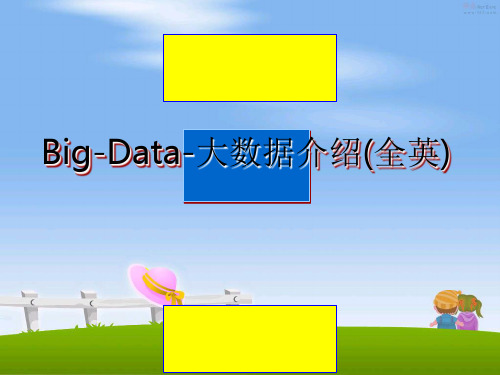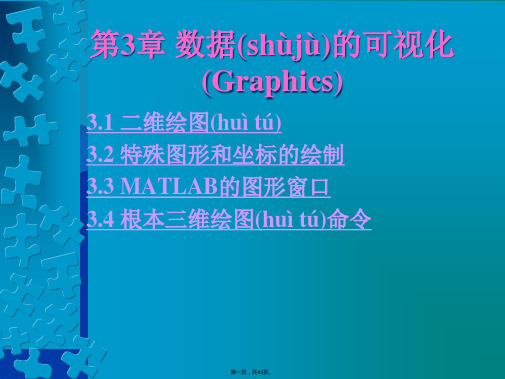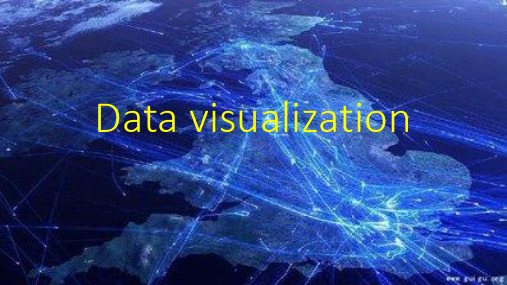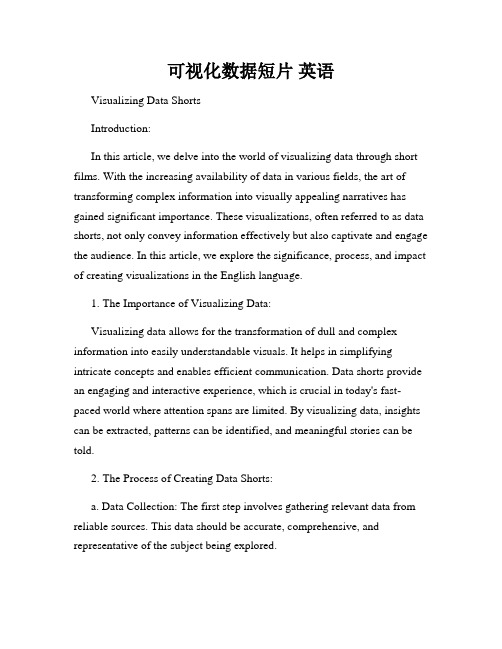数据可视化英文PPT概要介绍
Python数据可视化实战PPT课件(共8章)第1章 Python数据可视化概述

28
比较常用数据可视化工具
1. Excel
➢ Excel是办公室自动化中非常重要的一款软件,大量的国际企业都依靠Excel进行数据管理。它不仅能够 方便的处理表格和进行图形分析,而且拥有强大的功能,如对数据进行自动处理和计算。Excel是微软 公司的办公软件Microsoft office的组件之一,是由Microsoft为Windows和Apple Macintosh操作系 统的电脑编写和运行的一款试算表软件。
Python数据可视化概述
目录
1
了解数据与数据可视化
2
熟悉常用的数据可视化图形
3
了解与比较Python与其他可视化工具
4
熟悉Python集成开发环境Jupyter
2
了解数据与数据可视化
➢ 数据是对客观事物的性质、状态以及相互关系等进行记载的物理符号或这些物理符号的组合。它是可识别 的、抽象的符号。数据不仅指狭义上的数字,还可以是具有一定意义的文字、字母、数字符号的组合、图 形、图像、视频、音频等,也是客观事物的属性、数量、位置及其相互关系的抽象表示。如“0、1、 2......”“阴、雨、下降、气温”“学生的档案记录、货物的运输情况”等都是数据。
大数据挖掘专家
6
了解数据可视化
2. 流程
➢ 数据可视化尽管涉及到的数据量大,业务复杂,分析繁琐,但是总遵循着一定的流程进行。如图所示。
需求分析
数据获取
数据处理
分析与可视化
分析报告
大数据挖掘专家
7
了解数据可视化
数据可视化流程说明如表所示。
步骤 需求分析 数据获取 数据处理
分析与可视化
分析报告
说明
需求分析的主要内容是基于对商业的理解,明确目标,整理分析框架和分析思路,确 定数据分析的目的和方法
最新Big-Data-大数据介绍(全英)ppt课件

Why ‘Big Data’ is a big Deal
Big data differs from traditional information in mind-bending ways: Not knowing why but only what The challenge with leadership is that it’s very driven by gut instinct in most cases Air travelers can now figure out which flights are likeliest to be on time, thanks to data scientists who tracked a decade of flight history correlated with weather patterns Publishers use data from text analysis and social networks to give readers personalized news. health care is one of the biggest opportunities, If we had electronic records of Americans going back generations, we'd know more about genetic propensities, correlations among symptoms, and how to individualize treatments.
Main steps in adopting an analytical system
QlikView完整介绍PPT课件

通过QlikView进行金融行业风险控制,提升风险管理水平。
详细描述
在金融行业中,风险控制至关重要。QlikView通过对各类金融数据进行深度分析 和可视化展示,帮助企业全面了解市场风险、信用风险和操作风险等,提升风险 管理水平,保障业务安全。
06 QlikView的未来发展与 展望
技术创新
业务场景拓展
强化在市场营销中的应用
QlikView可能会进一步强化其在市场营销领域的应用,帮助企业更好地理解客户需求 和市场趋势。
拓展在运营管理中的应用
除了数据分析,QlikView还可能会拓展其在运营管理领域的应用,帮助企业实现精细 化管理。
合作伙伴关系建设
与更多数据源和服务提供 商合作
QlikView可能会与更多的数据源和服务提 供商建立合作关系,为用户提供更全面的数 据服务。
提供多种数据分析工具,如筛选器、 计算字段、度量值等,可以对数据进 行深入分析。
提供完整的数据分析流程,包括数据 探索、建模和优化等,帮助用户更好 地理解数据。
数据挖掘
支持数据挖掘功能,可以通过关联分 析、聚类分析等手段,发现数据背后 的规律和趋势。
数据报表
报表生成
支持快速生成各种报表,如销售 报表、财务报告等,满足日常报
数据可视化
图表类型丰富
提供多种图表类型,如柱 状图、折线图、饼图、地 理图等,满足不同数据可 视化需求。
数据交互式
用户可以通过交互式操作, 如缩放、旋转、过滤等, 深入探索数据之间的关联。
数据可视化效果
支持丰富的视觉效果,如 颜色、形状、大小等,可 以直观地展示数据特点。
数据分析
数据分析工具
数据分析流程
用于数据分析和商业 智能
第3章 数据的可视化(Graphics) 《MATLAB教程及实例(第1版)》课件(共43张PPT)

3.2 特殊图形(túxíng)和坐标的绘制 (Specialized Plotting)
3.2.1 特殊图形(túxíng)绘制
在MATLAB R2021a的 Workspace窗口中,如果 (rúguǒ)选择了Workspace 窗口中的某个内存变量, 单击工具栏中的绘制列数 据曲线按钮〔Plot〕,出现 下拉的菜单可以绘制各种 不同的特殊图形。
>> subplot(2,1,1)
>> hist(x,20) %分20段
>> subplot(2,1,2)
>> hist(x,-3:1:3) %确定每段中间值
>> sum((x<=2.5)&(x>1.5))
第二十一页,共43页。
5. 离散数据图
〔1〕stem函数
将数据用一个垂直于横轴的火柴棒表示 ,火柴头的小圆表示数据点。
第3章 数据(shùjù)的可视化 (Graphics)
3.1 二维绘图(huìtú) 3.2 特殊图形和坐标的绘制 3.3 MATLAB的图形窗口 3.4 根本三维绘图(huìtú)命令
第一页,共43页。
3.1 二维绘图(2-D plotting) 3.1.1 绘图的一般(yībān)步骤
1. 曲线数据准备 2. 指定图形窗口和子图位置 3. 绘制图形 4. 设置坐标轴和图形注释 5. 仅对三维图形使用的着色和视点(shì diǎn)等设置 6. 图形的精细修饰 7. 按指定格式保存或导出图形
5.使用鼠标添加注释文字 gtext('s') %用鼠标把字符串放在图形上 gtext({'s1','s2','s3',...}) %一次将多个的字 符串分行(fēn xínɡ)放置在图形上 gtext({'s1';'s2';'s3';...}) %一次放置一个字 符串分屡次放置在图形上
《数据可视化》教学课件—项目一 认识数据可视化

(一)认识Tableau
Tableau Public Tableau Public 是一款免费的桌面应用程序,用户可以连接Tableau Public服务器上的数据,设计和创建自己的 工作表、仪表板和工作簿,并把成果保存到大众皆可访问的Tableau Public服务器上(不可以把成果保存到本 地电脑上)。Tableau Public使用的数据和创建的工作簿都是公开的,任何人都可以与其互动并可随意下载, 还可以根据你的数据创建自己的工作簿。
3
认识数据可视化 工具Tableau
(一) 认识Tableau (二) 了解Tableau经典案例
(一)认识Tableau
1. Tableau简介 Tableau是美国Tableau软件公司出品的一款专业的商业智能软件,能够满足企业的数据分析需求。Tableau目 前在全球的用户已超过50000家,在中国的用户已超过2000家。
(一)认知数据可视化的意义
1.高效获取信息 人脑对视觉信息的处理要比书面信息容易得多。使用图表总结复杂的数据,可以确保对数据信息的
理解比混乱的电子表格或者文字报告更快。 数据可视化提供了一种非常清晰的沟通方式,使业务领导者能够更快地理解和处理他们的信息。用
一些简单的图形就能体现复杂的信息,甚至单个图形也能做到。决策者可以通过交互元素以及类似的数据可视化有助于让忙碌的管理者及业 务伙伴了解问题和制定有效计划。
图1-1
(二)了解企业中数据可视化的应用
2.电商行业 电商行业是近年来较为火爆的数据可视化分析领域,电子商务产生的数据有很大的挖掘价值。对于电商 来说订单数据是最直接相关的数据,通过将这部分数据可视化处理,可以清晰的观测订单量、销售额、 利润额等等情况。如图1-2所示是订单数据看板,除了一些数据指标卡以外,还有地图、条形图用来描述 数据。
数据分析与可视化的流程结构英语

数据分析与可视化的流程结构英语The Data Analysis and Visualization Workflow: A Comprehensive Overview.Introduction.Data analysis and visualization are critical processes for extracting meaningful insights from complex datasets. The workflow involves multiple stages, each with its own set of tools and techniques, and understanding the proper sequence of these stages is essential for effective data analysis. This article provides a comprehensive overview of the data analysis and visualization workflow, outlining the key steps involved and highlighting best practices for each stage.Step 1: Data Collection and Acquisition.The first step in the data analysis and visualization workflow is data collection and acquisition. This involvesgathering the relevant data from various sources, such as databases, surveys, experiments, and social media platforms. The quality of the data collected is crucial, as itdirectly impacts the accuracy and reliability of the subsequent analysis and visualization. Data cleaning and preprocessing techniques are often employed to ensure data accuracy and consistency.Step 2: Data Exploration and Understanding.Once the data is collected, it needs to be explored and understood to identify patterns, trends, and potential relationships. Exploratory data analysis (EDA) techniques, such as descriptive statistics, frequency distributions,and scatterplots, are used to gain insights into the data and formulate hypotheses for further investigation. This stage helps in identifying outliers, missing values, and potential biases that can impact the analysis.Step 3: Data Preparation and Transformation.Data preparation and transformation involve modifyingthe data to make it suitable for analysis and visualization. This includes data cleaning, feature engineering, and data transformation techniques. Data cleaning involves removing duplicate data, handling missing values, and correctingdata inconsistencies. Feature engineering involves creating new features or modifying existing features to enhance the quality and accuracy of the analysis. Data transformation techniques, such as normalization, scaling, and binning,are used to prepare the data for specific visualization and modeling techniques.Step 4: Data Modeling and Analysis.Data modeling and analysis involve applying statistical and machine learning techniques to the data to uncover patterns and relationships. Statistical models, such as regression models, time series models, and clustering algorithms, are used to identify significant relationships and make predictions. Machine learning models, such as supervised learning and unsupervised learning algorithms, are used for classification, prediction, and pattern recognition tasks.Step 5: Data Visualization and Interpretation.Data visualization is the process of presenting data in a graphical format to communicate insights and findings effectively. Choosing the appropriate visualization technique is crucial to ensure that the data is presentedin a clear and concise manner. Common visualization techniques include bar charts, histograms, scatterplots, line charts, and heat maps. The choice of visualization technique depends on the type of data, the purpose of visualization, and the target audience.Step 6: Communication and Storytelling.The final step in the data analysis and visualization workflow is communication and storytelling. This involves presenting the findings and insights derived from the data analysis in a clear and compelling manner. Effective communication involves presenting the results in a logical and structured way, highlighting the key findings, and providing actionable recommendations. Storytellingtechniques can be used to engage the audience, make the findings relatable, and inspire action.Best Practices for Each Stage.Data Collection and Acquisition: Ensure data quality, relevance, and representativeness.Data Exploration and Understanding: Use EDA techniques to identify patterns, trends, and potential relationships.Data Preparation and Transformation: Clean the data, handle missing values, and transform data as needed to improve analysis and visualization.Data Modeling and Analysis: Select appropriate statistical and machine learning techniques based on the research question and data characteristics.Data Visualization and Interpretation: Choose visualization techniques that effectively communicate insights and findings.Communication and Storytelling: Present results clearly, highlight key findings, and provide actionable recommendations.Conclusion.The data analysis and visualization workflow is a multifaceted process that requires a combination of technical skills, analytical thinking, and effective communication abilities. Understanding the proper sequence of steps and adhering to best practices for each stage are crucial for successful data analysis and visualization. By following a structured and iterative approach, organizations can harness the power of data to gain valuable insights, make informed decisions, and drive business outcomes.。
第六章 数据可视化- IDL课件

6.5 绘制文本XYouts
• 在坐标系中绘制任意文本内容。可以在当前窗口中的指定位置输出任 意格式的文本信息 • 格式:XYouts, [x,y,]string[,Alignment=value{0.0 to 1.0}][,charsize=value][,charthci=value][,width=variable][,/T3D][,Text_ axes={0|1|2|3|4|5}][,Clip=[x0,y0,x1,y1]][,color=value][,/Data|,/Device| ,/Normal][,Font=integer][,Orietation=ccw_degrees_from_horiz][,/Nocl ip][,z=value] • 关键字使用方法: Alignment:设定输出的文本对齐方式,0.0左,0.5居中,1.0右 Text_Axes:在进行三维输出时,设置文本的输出平面,0(xy),1(xz), 2(yz),3(yx),4(zx),5(zy) Width:文本信息的宽度 Orientation:倾斜程度
• • • • • • • • • •
/nodata Charsize = value: 字体的大小 {x|y|z}charsize = value: x,y,z轴上字体的大小 Font = integer :字体系统 Ticklen = value: 小刻度的尺度 {x|y|z}gridstyle = integer{0 to 5}:5种刻度类型 {x|y|z}margin = [left, right]: 轴边界的空白 {x|y|z}minor = integer: 最小刻度间隔的数目 {x|y|z}range = [min, max]: 最小和最大范围 {x|y|z}style = value: 坐标轴的类型: 0 由range指定的精确范围 2 每边留空余 4 不显示整个坐标轴 8 只在左边或下边显示坐标轴 16 不强行规定y的起始点为0 这些类型可以用加号进行多重设置 如: 0+8
《数据可视化》PPT课件 (2)教学文案

28
(4)添加图例
legend(s,pos) 在指定位置建立图例
legend off
擦除当前图中的图例
说明:参数s是图例中的文字注释,为字符串。 如果多个注释,则可以用s1,s2,…的方式;参 数pos是图例在图上位置的指定符
29
legend(s,pos) 在指定位置建立图例
legend off
17
表明图形的横纵坐标为t,x,曲线颜色为 黑色,线型为点连线,数据点用圆圈 标出。
18
19
5.1.4 设置坐标轴和文字标注
1.坐标轴的控制
坐标控制命令axis可用来控制坐标的特性,最常用的 命令是: axis([xmin,xmax,ymin,ymax])
该命令在使用时应注意,必须满足xmin<xmax, ymin<ymax,这四个数值可以取inf或–inf。
61
5.3 符号函数图形的绘制
5.3.1 fplot 函数
fplot(f,[xmin,xmax]) 说明:绘制给定函数在区间 [xmin,xmax] 内的变化图形,f 为一元函数表达式,为字 符型数据,不可为符号对象。
62
63
fplot只支持字符定义方式,而 不支持符号定义方式。
64
5.3.2 ezplot 函数
使用figure语句可以同时打开多个图 形窗口,其调用格式为: figure(n):产生新图形窗口。 说明:如果该窗口不存在,则产生新 图形窗口并设置为当前图形窗口,该 窗口名为“Figure No.n”,而不关 闭其他窗口。
8
自动出现第一个窗口 在第二个窗口绘图 在第三个窗口绘图
9
2.同一窗口多个子图
41
42
数据可视化简介ppt

Tree Tap
Tool
Entry-level tools Advanced tools
• Excel • CSV/JSON
• Processing • NodeBox
Online data visualization tools
• Flot
• D3
• Raphael
• Visual.ly
• Google Char API
• As a starter kit, Excel is an ideal tool to quickly analyze data, and create a data graph for internal use, but Excel in colors, lines and patterns on the optional scope is limited, this also means that using Excel is difficult to produce can met the need of the professional publications and website data. But as an efficient internal communication tool, Excel is supposed to be one of the necessary tools in your chest.
Heat map
This visualization is very intuitive reflect the Internet web site overall proportion of types, Tree Tap is a very typical application scenario, use a Tree Map in the fully manifested intuitively, at the same level at the same time under the same type and different types for the subset size comparison.
医疗数据可视化ppt课件

虚拟活检通过无创性虚拟影像学检查即可获得病 理学信息,与探针式活检相比具有突出优点,或 者利用虚拟影像指导活检穿刺,或者利用各种现 代成像手段获取有关信息后,综合分析以获得病 变形态和功能参数。
治疗 可视
虚拟手术
虚拟手术利用计算机技术(主要是计算机图形学与虚拟 现实来模拟、指导医学手术所涉及的各种过程。术前 可视化仿真技术可帮助医生合理、定量地定制手术方 案,辅助选择最佳手术途径、提高病灶定位精度、减 少对组织损害;可以预演手术的整个过程以便事先发现 手术中可能出现的问题
63%
42%
2005 至2010年全球非自然死亡的比例分布图
经营者提供商品或者服务有欺诈行为 的,应 当按照 消费者 的要求 增加赔 偿其受 到的损 失,增 加赔偿 的金额 为消费 者购买 商品的 价款或 接受服 务的费 用
2015年《解构春雨医生》的报告
这张表格蕴含了很多信息,包括春雨医生各种 类收入,各科室收入,及各科室在各种类收入 中所占的构成比例,一眼看去,满目数字,很 难快速地获取综合信息。
远程监护
危重病人日常及术后监护、慢性病 日常监护、老人看护和救助、孕妇 、婴幼儿看护等都会涉及远程监护 。病患通过远程监护仪,传达健康 数据,供医生分析。
经营者提供商品或者服务有欺诈行为 的,应 当按照 消费者 的要求 增加赔 偿其受 到的损 失,增 加赔偿 的金额 为消费 者购买 商品的 价款或 接受服 务的费 用
经营者提供商品或者服务有欺诈行为 的,应 当按照 消费者 的要求 增加赔 偿其受 到的损 失,增 加赔偿 的金额 为消费 者购买 商品的 价款或 接受服 务的费 用
以上两例说明了图示对展示数据的重要性和有效性。
随着大数据时代的到来,数据视觉化变得尤为关键。
数据可视化图表PPT- (5)

6 5 4 3 2 1 0
2011
2012
2013
2014
2015
2016
2
55%
Conveniently architect
45%
Conveniently architec
点击输入标题
Seamlessly deliver client-centered methods of empowerment via market-driven metrics. Enthusiastically enhance front-end webreadiness via standards compliant paradigms. Professionally orchestrate sustainable.
$80 BN
Collaboratively re-engineer user friendly interfaces with empowered mindshare. Competently synthesize magnetic leadership skills without functional experiences.
13
Business Chart
7,450
Business Chart
3,110
Business Chart
9,210
Business Chart
4,230
$80 BN
Markerting Plan 2018
Collaboratively re-engineer user friendly interfaces with empowered mindshare. Competently synthesize magnetic leadership skills without.
数据可视化ppt

的二维图形显示的理论,强调有用
信息密度的最大化问题。这些理论
图1
图1 美国可视化人体数据切片之一 1975年图统1计1图95形7年学发家明发的明圆的形增图强标散,点采图用表线达段及其18朝00向—编19码00多年维:数图数据2据J图oh形n
图2 采用直接体可视化技术绘制鳄鱼木会乃同伊JCaTcq数u据es Bertin的图形符号学,
的医学影像数据、三维空间信息测量数据、流体计 算模拟数据等。由于数据的规模通常超过图形硬件 的处理能力,所以如何快速地呈现数据中包含的几 何、拓扑、形状特征和演化规律是其核心问题。随 着图形硬件和可视化算法的迅猛发展,单纯的数据 显示已经得到了较好的解决。 • 信息可视化的核心问题主要有高维数据的可视化、 数据间各种抽象关系的可视化、用户的敏捷交互和 可视化有效性的评断等。 • 可视分析偏重于从各类数据综合、意会和推理出知 识,其实质是可视地完成机器智能和人脑智能的双 向转换,整个探索过程是迭代的、螺旋式上升的过 程。
列作图一个模块,从而提供了一个统一的数据分析界面。
于开源智能19数75据—源19(87O年pe:n-多So维u统rce计In图te形lligence(OSINT),如学术研究、博客、新闻媒
1987—2004年:交互可视化 体、非政府组织报告和联合国研究等),实现人物、关系、时间、统计、地理信息、社
2004年至今:图可3视1分99析1年学Ben
数据可视化英文PPT概要介绍

The goal of visualization is to aid our understanding of
data by leveraging['lev(ə)rɪdʒ] the human visual system's highly-tuned ability to see patterns, spot trends, and identify outliers. Well-designed visual representations can replace cognitive calculations with simple perceptual inferences['ɪnfərəns] and improve comprehension, memory, and decision making. By making data more accessible and appealing, visual representations may also help engage more diverse audiences in exploration and analysis. The challenge is to create effective and engaging visualizations that are appropriate to the data.
The Graphics Department of the NY Times, including
Amanda Cox, Shan Carter and many others, has recently created a number of visualizations of complex phenomena that are at once stunningly beautiful and effective in communicating the essential ideas to a mass audience. Web-based versions now allow them to use dynamic and interactive graphics to go beyond what can be shown in static print versions. This image, from May 3, 2008, shows the changes in prices from March, 2007 to March, 2007 of various components of an average consumer's spending. The circular diagram is broken up into 8 main sectors, whose area is proportional to the percent of
第9章 数据可视化技术 大数据基础PPT课件

数据可视化概述
进入20世纪,数据可视化有了飞跃性的发展。数据可视化的方式可以分为面 积与尺寸可视化、颜色可视化、图形可视化、地域空间可视化和概念可视化等。 (1)面积与尺寸可视化
对同一类图形(例如柱状、圆环图等)的长度、高度或面积加以区别,表达 不同指标对应的指标值之间的对比。制作这类可视化图形需要用数学公式计算 出准确的尺度和比例。 (2)颜色可视化
通过颜色的深浅来表达指标值的强弱和大小,是数据可视化设计的常用方法, 用户可直观地发现哪一部分指标的数据值更加突出,例如,热力图。 (3)图形可视化
在设计指标及数据时,使用有对应实际含义的图形结合呈现数据,会使数据 图表更加生动,便于用户理解图表要表达的主题。
数据可视化概述
(4)地域空间可视化 当指标数据要表达的主题与地域有关联时,一般会选择用地图作为大背
OLAP可视化工具
2.微软Power BI 微软Power BI是一套商业分析工具,可连接数百个数据源,简化了数
据准备流程并提供即席分析功能。Microsoft Excel在很早以前就支持了 数据透视表,并基于Excel开发了相关的BI插件,如用于数据获取和数据 整理的Power Query,用于建模分析PowerPrivot,图表交互工具Power View和基于地图的数据可视化工具Power Map等。相比于其他同类产品, 它有着无可比拟的天然优势。熟悉Excel报表和BI分析的用户可以快速上 手,甚至可以直接使用以前的模型。Power BI已经支持包括Excel、 CSV、XML、Json、文本文件等多种文件数据源及常见Access、 MSSQL、Oracle、Mysql等关系数据库。
桌面可视化技术
2.SPSS 统计产品与服务解决方案(Statistical Product and Service,SPSS),
可视化数据短片 英语

可视化数据短片英语Visualizing Data ShortsIntroduction:In this article, we delve into the world of visualizing data through short films. With the increasing availability of data in various fields, the art of transforming complex information into visually appealing narratives has gained significant importance. These visualizations, often referred to as data shorts, not only convey information effectively but also captivate and engage the audience. In this article, we explore the significance, process, and impact of creating visualizations in the English language.1. The Importance of Visualizing Data:Visualizing data allows for the transformation of dull and complex information into easily understandable visuals. It helps in simplifying intricate concepts and enables efficient communication. Data shorts provide an engaging and interactive experience, which is crucial in today's fast-paced world where attention spans are limited. By visualizing data, insights can be extracted, patterns can be identified, and meaningful stories can be told.2. The Process of Creating Data Shorts:a. Data Collection: The first step involves gathering relevant data from reliable sources. This data should be accurate, comprehensive, and representative of the subject being explored.b. Data Analysis: After collecting the data, it needs to be carefully analyzed to identify trends, patterns, and key insights. This step is crucial in determining the main message that the data short will convey.c. Storytelling: Once the data has been analyzed, the next step is crafting a compelling narrative. The story should have a clear structure, a well-defined beginning, middle, and end, and should effectively communicate the main findings of the data.d. Visual Design: The visual design is an essential element in data shorts. It involves selecting appropriate colors, fonts, and graphic elements to enhance the story and convey the information clearly. The visual design should be visually appealing, consistent, and easy to understand.e. Animation and Motion: Adding animation and motion brings the data to life and engages the audience. Utilizing various techniques such as transitions, panning, zooming, and animated data points can enhance the visual appeal and help in telling a more compelling story.f. Sound Design: The addition of sound effects, background music, and narration can further enhance the audience's experience. It adds depth and emotion to the visualization, making it more immersive and engaging.3. The Impact of Data Shorts:a. Effective Communication: Data shorts enable complex information to be communicated effectively to a wide range of audiences. Through visual storytelling, data becomes more accessible, understandable, and memorable.b. Decision Making: Visualizing data in the form of shorts can aid decision-making processes. The clear presentation of insights allowspolicymakers, researchers, and businesses to make informed choices based on the data presented.c. Advocacy and Awareness: Data shorts have the power to raise awareness and drive change. By combining compelling visuals with impactful narratives, data shorts can bring attention to important social, economic, and environmental issues.d. Education and Learning: Visualizing data in short films can enhance the learning experience by presenting information in an engaging and relatable manner. Students, researchers, and educators can benefit from visually appealing data representations that convey complex concepts concisely.Conclusion:Visualizing data through shorts is a powerful tool for conveying complex information in an engaging and easily understandable format. By combining compelling narratives with visually appealing designs, data shorts have the potential to captivate and inspire audiences across different fields. The significance of visualizing data cannot be underestimated, as it facilitates effective communication, aids decision-making, raises awareness, and enhances the learning experience. Embracing the art of data visualization has the potential to transform the way we explore, understand, and communicate information.。
数据可视化 Making the complex beautifully clear (PPT)

/?business&aid=6&un=foxmouse521#7
Color
Type
Scale
Depth
Shape
Value
Line
Grid
/?business&aid=6&un=foxmouse521#7
I LOVE TO DESIGN INFORMATION
/?business&aid=6&un=foxmouse521#7
75
/?business&aid=6&un=foxmouse521#7
/?business&aid=6&un=foxmouse521#7
/?business&aid=6&un=foxmouse521#7
WHY IS VISUALIZING INFORMATION SO IMPORTANT?
/?business&aid=6&un=foxmouse521#7
18
/?business&aid=6&un=foxmouse521#7
19
/?business&aid=6&un=foxmouse521#7
Transition
Movement
Animation
Sound
Interactive-specific toolkit
(included thanks to Peter and Ben from )
/?business&aid=6&un=foxmouse521#7
Location
Alphabetical
- 1、下载文档前请自行甄别文档内容的完整性,平台不提供额外的编辑、内容补充、找答案等附加服务。
- 2、"仅部分预览"的文档,不可在线预览部分如存在完整性等问题,可反馈申请退款(可完整预览的文档不适用该条件!)。
- 3、如文档侵犯您的权益,请联系客服反馈,我们会尽快为您处理(人工客服工作时间:9:00-18:30)。
The French engineer, Charles Minard (1781-1870),
illustrated the disastrous[dɪ'zæ strəs] result of Napoleon's [nə'pəuliən] failed Russian campaign of 1812. The graph shows the size of the army by the width of the band across the map of the campaign on its outward and return legs, with temperature on the retreat shown on the line graph at the bottom. Many consider Minard's original the best statistical graphic ever drawn.
All is above ,Thank you !
Now , we provide a brief tour through the "visualization zoo"
Here we go !!!
The most famous, early example mapping
epidemiological['ɛpɪ,dimɪə'lɑdʒɪkl] data was Dr. John Snow's map of deaths from a cholera['kɑlərə] outbreak in London, 1854, in relation to the locations of public water pumps. Snow observed that cholera occurred almost entirely among those who lived near and drank from the Broad Street water pump. He had the handle of the contaminated[kən'tæ mɪnetɪd] pump removed, ending the neighborhood epidemic which had taken more than 500 lives.
The goal of visualization is to aid our ging['lev(ə)rɪdʒ] the human visual system's highly-tuned ability to see patterns, spot trends, and identify outliers. Well-designed visual representations can replace cognitive calculations with simple perceptual inferences['ɪnfərəns] and improve comprehension, memory, and decision making. By making data more accessible and appealing, visual representations may also help engage more diverse audiences in exploration and analysis. The challenge is to create effective and engaging visualizations that are appropriate to the data.
spending, and each of these is subdivided in
proportion to sub-categories. A bipolar color scale is used to shade each region, using shades toward redishbrown for increases and shades toward blue for decreases. The interactive version of this diagram uses tool-tip boxes to show the details and allows zooming in on components whose labels cannot be shown in a static graph. The basic graphic form is an adaptation of a pie chart to a hierarchical data structure, based on the idea of a Voronoi tree-map by Michael Balzer and others at the University of Konstanz.
We have now arrived at the end of our tour, and hope that
the reader has found examples both intriguing [ɪn‘triɡɪŋ] and practical. Though we have visited a number of visual encoding and interaction techniques, many more species of visualization exist in the wild, and others await discovery. Emerging domains such as bioinformatics and text visualization are driving researchers and designers to continually formulate new, creative representations or find more powerful ways to apply the classics. In either case, the "DNA" underlying all visualizations remains the same: the principled mapping of data variables to visual features such as position, size, shape, and color. As you leave the zoo and head back into the wild, see if you can deconstruct the various visualizations crossing your path. Can you do better?
The Graphics Department of the NY Times, including
Amanda Cox, Shan Carter and many others, has recently created a number of visualizations of complex phenomena that are at once stunningly beautiful and effective in communicating the essential ideas to a mass audience. Web-based versions now allow them to use dynamic and interactive graphics to go beyond what can be shown in static print versions. This image, from May 3, 2008, shows the changes in prices from March, 2007 to March, 2007 of various components of an average consumer's spending. The circular diagram is broken up into 8 main sectors, whose area is proportional to the percent of
By 朱兴宇 & 蔡慧敏
Visualization, as a discipline in computer science, is a rather young field of study. The field has made many advances over the past 25 years through tremendous basic and application-driven research efforts, and also successfully transferred some of these advances into products and services for data-intensive applications. Visualization as a problem-solving and knowledge discovery tool has become even more important as we enter the Big Data area. Its applications grow from scientific computing, engineering design, biomedicine, cyber security, and intelligence, to social science, transportation studies, and commerce. Visualization will be considered a basic skill, and will likely become part of the standard curriculum in science and engineering.
